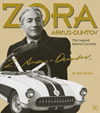|
Zora Arkus-Duntov: The Legend Behind Corvette
by Jerry Burton
Price: $49.95
|

Detroit Free Press - Thursday, September 5, 2002
Russian Engineer saved slow-seller Corvette
The Chevrolet Corvette has grown into an American cultural icon, but a cosmopolitan Russian immigrant was largely responsible for its success.
The picaresque life of Zora Arkus-Duntov is richly documented in this definitive biography by Jerry Burton.
Born to Russian parents in 1909, Duntov lived through the revolution of 1917 in Petrograd, where his mother lager had an affair with the artist marc Chagall. And Duntov’s willful reckless nature showed itself early, with the teenager shooting his way through a door and pistol-marching a reluctant doctor for miles to attend to his gravely ill mother.
Trained in Germany as an engineer, the Jewish-born Duntov boxed and raced motorcycles but failed to parlay his way into the legendary Mercedes-Benz and Auto Union race teams. He eventually fled Nazi Germany and enlisted in the French military before escaping Nazi-occupied France for New York.
The sight of the first Corvette in New York at the 1953 Motorama show stopped Duntov in his tracks though he knew that "mechanically it stunk" with its weak six-cylinder engine and two-speed transmission. But the engineer and race-driver, who had enjoyed huge success in America with his Ardun engine during World War II, courted General Motors and landed and assistant engineer’s job in Detroit, where his personality conflicts and side trip to Le Mans to race got him exiled to Milford to work on trucks.
But Duntov continued to act as if Corvette were his. And Duntov’s then-radical ideas about high performance helped transform Chevrolet’s stodgy reputation and create the first market for American sports cars. His insistence that the Corvette would fail withot racetrack credibility and European -style performance likely saved the slow-selling car from extinction. Duntov’s reputation grew when he designed fuel injection fo the Corvette’s V8 for 1957, a first for an American car. Shrewd publicity followed, such as Duntov’s high-speed runs on the sand at Daytona, Fla., in 1958.
Burton’s book works as absorbing biography and as richly detailed history of GM and the evolution of Corvette. Burton delves deeply into Duntov’s maverick streak, which worked to his benefit and detriment within the starched-collar confines of GM. And it documents the internal struggles, including the clash between Duntov and GM chief designer Bill Mitchell over the ’63 Sting Ray’s split window, which shaped America’s sports car.
By the late ’60s, Duntov found himself increasingly isolated from decision making on future Corvettes, though he was the car’s public hero among enthusiasts and the media.
Duntov retired in late 1974 and died in 1996. But his reputation as the Corvette champion remains.

![[B] Bentley Publishers](http://assets1.bentleypublishers.com/images/bentley-logos/bp-banner-234x60-bookblue.jpg)
